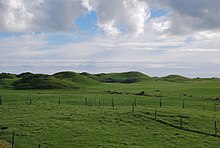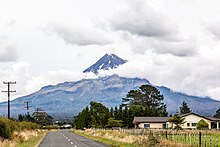User:Ddaveonz/sandbox/Taranaki
Volcanic activity
[edit]Taranaki is geologically young, having commenced activity approximately 135,000 years ago. The most recent volcanic activity was the production of a lava dome in the crater and its collapse down the side of the mountain in the 1850s or 1860s.[1][2] Between 1755 and 1800, an eruption sent a pyroclastic flow down the mountain's northeast flanks,[3] and a moderate ash eruption occurred about 1755, of the size of Ruapehu's activity in 1995/1996. The last major eruption occurred around 1655. Recent research has shown that over the last 9,000 years minor eruptions have occurred roughly every 90 years on average, with major eruptions every 500 years.
Hazards
[edit]
Taranaki is unusual in that it has experienced at least five of its major eruptions by the method of cone collapse. Few volcanoes have undergone more than one cone collapse. The vast volume of material involved in these collapses is reflected in the extensive ringplain surrounding the volcano. There is also evidence of lahars being a common result of eruption.
Much of the region is at risk from lahars, which have reached as far as the coast. A volcanic event is not necessary for a lahar: even earthquakes combined with heavy rain or snow could dislodge vast quantities of unstable layers resting on steep slopes. Many farmers live in the paths of such possible destructive events.
Although volcanic eruptions are notoriously chaotic in their frequency, some scientists warn that a large eruption is "overdue". Research from Massey University indicates that significant seismic activity is likely again in the next 50 years. Prevailing winds would probably blow ash east, covering much of the North Island, and disrupting air routes, power transmission lines and local water supplies.[4]
Older volcanoes in the area
[edit]
Taranaki sits on the remains of three older volcanic complexes that lie to the northwest. The Indo-Australian Plate is slowly moving relative to the magma source that feeds these volcanoes. This trend is reflected in Fanthams Peak, the newer secondary cone on the southeast side of Taranaki.
The oldest volcanic remnants consist of a series of lava plugs: Paritutu Rock (156m), which forms part of New Plymouth's harbour, and the Sugar Loaf Islands close offshore. These have been dated at 1.75 million years.
On the coast 15 km southwest of New Plymouth is the Kaitake Range (682m), last active approximately 500,000 years ago.
Nearest to Taranaki is the Pouakai Range. Pouakai may have originated around the same time as Kaitake but remained active until about 240,000 years ago. Much of Pouakai's large ringplain was obliterated by the Egmont Volcano, the hills near Eltham being the only remnant to the south.[1]
Geology
[edit]Geologic setting
[edit]Taranaki is a basaltic andesite stratovolcano located within the Taranaki Basin on the west coast of the North Island. Volcanism at Taranaki is caused by the subduction of the Pacific Plate under the Australian Plate at the Hikurangi Trench to the east of the North Island. Taranaki is unique amongst New Zealand's stratovolcanoes in that it is situated behind the volcanic arc, being located approximately 130 km to the west of it.
Taranaki is the youngest and southernmost member of the Taranaki Volcanic Lineament, which is marked by a line of extinct and highly-eroded volcanoes that stretch away to the northwest of Taranaki. Over time, volcanic activity at the Taranaki Volcanic Lineament has progressed towards the southeast, starting with the Sugar Loaf Islands and Paritutu, which were active approximately 1.75 million years ago, followed by Kaitake approximately 575,000 years ago and Pouakai approximately 240,000 years ago. [5]
Volcanic history
[edit]Eruptions began at Taranaki more than 130,000 years ago[5] and perhaps as early as 200,000–210,000 years ago.[6][7] Its history is characterized by cyclic growth and collapse of the volcanic cone.[8][9] Over a period of several thousand years, eruptions build the cone up until it reaches a critical size, after which a catastrophic cone collapse occurs, similar to the May 1980 collapse of Mt St. Helens that removed a large part of the mountain.[10] Avalanche deposits and pyroclastic flow deposits from these cone collapses can be found right across the Taranaki Peninsula, and some deposits extend up to 8 km offshore.[5][11] Mt Taranaki has collapsed and re-grown 16 times over its lifetime, with five collapses recognized during the past 30,000 years.[8][9]
Although the volcano itself is up to 210,000 years old, the current mountain is only 5,000–6,000 years old due to this cycle of cone growth and collapse.[6] One of the largest collapses in Taranaki's history occurred about 25,000 years ago, which removed as much as 7.5 km3 of material from the cone. By comparison, that is approximately 3 times the amount of material lost from Mt St. Helens in its 1980 collapse.[10] This collapse reduced Taranaki's height to approximately 1,000 m and buried the land to the west of the mountain in up to 16 m of avalanche deposits.[11] Since then, the mountain has grown and collapsed twice more, approximately 14,000 years ago and 7,500 years ago.[11][10] Mt Taranaki's current cone is inherently unstable due to its steepness and composition (the cone consists of layers of unconsolidated eruption deposits that sit between layers of lava flows). Because of this, it is likely the the current cone will also collapse eventually , and the cycle will begin anew.[7][8]
As the cone gets higher over several thousand years, pyroclastic flows reach further and further away. Pyroclastic flow deposits at Taranaki have been found more than 25 km away from the volcano.[8]
228 individual ash-producing eruptions have been identified over the last 30,000 years.[12]
A second cone had been built by 35,000 years ago, which suffered sector collapses and large avalanches between 30,000 and 23,000 years ago, leaving extensive deposits to the southeast of the mountain, between the modern towns of Stratford and Eltham.[5] These collapses reduced the height of the volcano to approximately 1,000 m. About 14,000 years ago, the modern cone above the 1,000 m contour began to be built.
Fantham's Peak
[edit]Fantham's Peak is a parasitic vent on the southern slopes of Taranaki. The most recent eruption from Fanthams Peak occurred in approximately the 8th Century AD.[13]
Maero Eruptive Period
[edit]Beginning in approximately AD 960, Mt Taranaki entered a new regime of volcanic activity, called the Maero Eruptive Period. 11 distinct eruptive episodes have been identified within this period.[13]
Future hazards
[edit]Mt Taranaki is centered in the middle of an economically significant region—one that hosts all of the country's productive oil and gas fields and approximately 25% of the country's dairy farming industry.[12]
Ash from Mt Taranaki has been found in the Waikato, in the Whanganui district, and in Lake Tutira in Hawkes Bay.[14]
The plains of the Taranaki peninsula are widely covered with small hills and mounds, which are the result of massive debris avalanches and cone collapse events burying the surrounding landscape. Given that the current mountain is a nearly perfect cone with steep upper slopes, Taranaki is probably nearing the end of its current cone growth cycle, which means there is a future risk of another cone collapse event occurring.[8][7] The exact hazards associate with such an event are difficult to determine as they will depend on a range of factors such as volcanic activity, seismic activity, and rainfall intensity.[8]
References
[edit]- ^ a b "Volcanic Taranaki". Puke Ariki. Archived from the original on 1 February 2013. Retrieved 18 March 2010.
- ^ "Taranaki (Egmont)". Global Volcanism Program. Smithsonian Institution.
- ^ Leighton Keith (11 October 2011). "Mt Taranaki volcano history revised". Taranaki Daily News. Retrieved 11 October 2011.
- ^ "Living With Volcanoes" (PDF), TEPHRA, vol. 21, Civil Defence, pp. 41–43, September 2004
- ^ a b c d Johnston, D; Becker, J; Jolly, G; Potter, S; Wilson, T; Stewart, C; Cronin, S. "Volcano Hazards Management at Taranaki Volcano: Information Source Book". GNS Science Report 2011/37.
- ^ a b Turner, Michael B.; Cronin, Shane J.; Bebbington, Mark S.; Smith, Ian E.M.; Stewart, Robert B. (December 2011). "Integrating records of explosive and effusive activity from proximal and distal sequences: Mt. Taranaki, New Zealand". Quaternary International. 246 (1–2): 364–373. doi:10.1016/j.quaint.2011.07.006.
- ^ a b c Alloway, Brent; McComb, Peter; Neall, Vince; Vucetich, Colin; Gibb, Jeremy; Sherburn, Steve; Stirling, Mark (March 2005). "Stratigraphy, age, and correlation of voluminous debris‐avalanche events from an ancestral Egmont Volcano: Implications for coastal plain construction and regional hazard assessment". Journal of the Royal Society of New Zealand. 35 (1–2): 229–267. doi:10.1080/03014223.2005.9517782.
- ^ a b c d e f Zernack, Anke V.; Procter, Jonathan N.; Cronin, Shane J. (October 2009). "Sedimentary signatures of cyclic growth and destruction of stratovolcanoes: A case study from Mt. Taranaki, New Zealand". Sedimentary Geology. 220 (3–4): 288–305. doi:10.1016/j.sedgeo.2009.04.024.
- ^ a b Cronin, Shane J.; Zernack, Anke V.; Ukstins, Ingrid A.; Turner, Michael B.; Torres-Orozco, Rafael; Stewart, Robert B.; Smith, Ian E. M.; Procter, Jonathan N.; Price, Richard; Platz, Thomas; Petterson, Michael; Neall, Vince E.; McDonald, Garry S.; Lerner, Geoffrey A.; Damaschcke, Magret; Bebbington, Mark S. (3 July 2021). "The geological history and hazards of a long-lived stratovolcano, Mt. Taranaki, New Zealand". New Zealand Journal of Geology and Geophysics. 64 (2–3): 456–478. doi:10.1080/00288306.2021.1895231.
- ^ a b c Zernack, Anke V.; Cronin, Shane J.; Bebbington, Mark S.; Price, Richard C.; Smith, Ian E.M.; Stewart, Robert B.; Procter, Jonathan N. (November 2012). "Forecasting catastrophic stratovolcano collapse: A model based on Mount Taranaki, New Zealand". Geology. 40 (11): 983–986. doi:10.1130/G33277.1.
- ^ a b c Zernack, A. V.; Cronin, S. J.; Neall, V. E.; Procter, J. N. (November 2011). "A medial to distal volcaniclastic record of an andesite stratovolcano: detailed stratigraphy of the ring-plain succession of south-west Taranaki, New Zealand". International Journal of Earth Sciences. 100 (8): 1937–1966. doi:10.1007/s00531-010-0610-6.
- ^ a b Damaschke, Magret; Cronin, Shane J.; Holt, Katherine A.; Bebbington, Mark S.; Hogg, Alan G. (January 2017). "A 30,000 yr high-precision eruption history for the andesitic Mt. Taranaki, North Island, New Zealand". Quaternary Research. 87 (1): 1–23. doi:10.1017/qua.2016.11.
- ^ a b Lerner, G. A. (2019). Defining Volcanic Regimes at Mt. Taranaki, New Zealand (Ph.D.). University of Auckland.
- ^ Alloway, Brent; Neall, V. E.; Vucetich, C. G. (December 1995). "Late Quaternary (post 28,000 year B.P.) tephrostratigraphy of northeast and central Taranaki, New Zealand". Journal of the Royal Society of New Zealand. 25 (4): 385–458. doi:10.1080/03014223.1995.9517496.
